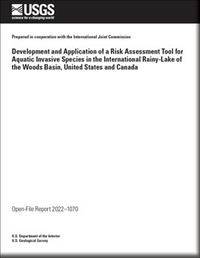Development and Application of a Risk Assessment Tool for Aquatic Invasive Species in the International Rainy-Lake of the Woods Basin, United States and Canada
Links
- Document: Report (1.2 MB pdf) , HTML , XML
- Datasets:
- NOAA database —Great Lake Aquatic Nonindigenous Species Information System (GLANSIS) Risk Assessment Clearinghouse
- USGS database —NAS—Nonindigenous Aquatic Species
- USGS database —Biodiversity Information Serving Our Nation (BISON)
- Download citation as: RIS | Dublin Core
Abstract
The Rainy-Lake of the Woods Basin covers 70,000 square kilometers in mid-central North America and is contained within the Provinces of Ontario and Manitoba in Canada and the State of Minnesota in the United States. This basin contains natural wilderness areas, national parks, and thousands of lakes that bring outdoor enthusiasts from around the world for hunting, fishing, backpacking, boating, and other forms of recreation. However, trade, commerce, visitors, and wildlife can inadvertently transport hitchhiking exotic invasive species that affect the functioning of natural systems by displacing native organisms, introducing diseases, and modifying predator/prey relations. In cooperation with the International Joint Commission, the U.S. Geological Survey evaluated the aquatic invasive species that pose a possible threat to North America. The outcome of this project is a set of lists of invasive species that have traits amenable or proximity to the Rainy-Lake of the Woods Basin. These lists can be referenced to further evaluate known and potential nonindigenous invasive species. The lists were derived by evaluating more than 1,500 species from several online sources including Non-Indigenous Aquatic Species, Great Lakes Aquatic Nonindigenous Species Information System, Biodiversity Information Serving Our Nation, and other State, Provincial, and Federal lists in the United States and Canada. The purpose of these lists is to be a coarse filter to determine which species pose the greatest risk to the Rainy-Lake of the Woods Basin. Using this filter, seven categories of risk assessment priorities were developed: Very High-Approaching, Very High-Present, High-Approaching, High-Present, Moderate, Low, and Native. These categories can be used by the International Rainy-Lake of the Woods Multi-Agency Arrangement Aquatic Invasive Species Subcommittee to prioritize which species will be evaluated further focusing on five risk factors: arrival risk, vulnerability assessment, ecological impact, socioeconomic impact, and beneficial impact. Based on proximity, ease of transport or introduction, and known impact to Rainy-Lake of the Woods or other impacted ecosystems, this project identified the following 10 species that could be prioritized first for risk evaluations: Bythotrephes longimanus (spiny waterflea), Faxonius rusticus (rusty crayfish), Neogobius melanostomus (round goby), Dreissena polymorpha (zebra mussel), Bithynia tentaculata (mud Bithynia or faucet snail), Potamopyrgus antipodarum (New Zealand mud snail), Butomus umbellatus (flowering rush), Nitellopsis obtusa (starry stonewort), Myriophyllum spicatum (Eurasian watermilfoil), and Phragmites australis australis (common reed).
Suggested Citation
Bell, A.H., Katona, L.R., and Vellequette, N.M., 2023, Development and application of a risk assessment tool for aquatic invasive species in the international Rainy-Lake of the Woods Basin, United States and Canada: U.S. Geological Survey Open-File Report 2022–1070, 26 p., https://doi.org/10.3133/ofr20221070.
ISSN: 2331-1258 (online)
Study Area
Table of Contents
- Acknowledgments
- Abstract
- Introduction
- Development of Lists and Ranking of Species
- Final Priority for Risk Evaluation Lists and Conclusions
- References Cited
| Publication type | Report |
|---|---|
| Publication Subtype | USGS Numbered Series |
| Title | Development and application of a risk assessment tool for aquatic invasive species in the international Rainy-Lake of the Woods Basin, United States and Canada |
| Series title | Open-File Report |
| Series number | 2022-1070 |
| DOI | 10.3133/ofr20221070 |
| Publication Date | November 07, 2023 |
| Year Published | 2023 |
| Language | English |
| Publisher | U.S. Geological Survey |
| Publisher location | Reston, VA |
| Contributing office(s) | Upper Midwest Water Science Center |
| Description | Report: vi, 26 p.; 3 Datasets |
| Country | Canada, United States |
| Online Only (Y/N) | Y |
| Additional Online Files (Y/N) | N |


